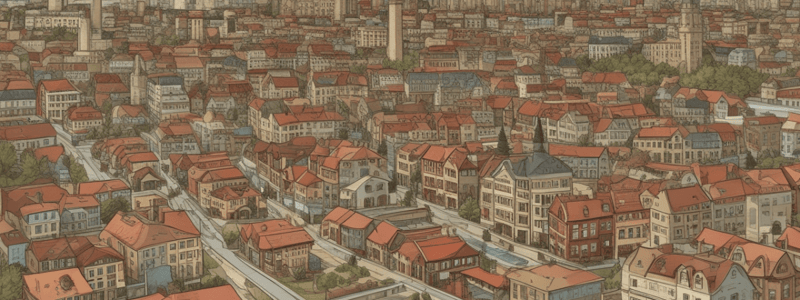Podcast
Questions and Answers
What is a common theme observed in reunions, whether it's a family reunion or a class reunion?
What is a common theme observed in reunions, whether it's a family reunion or a class reunion?
- Reflecting on changes over time (correct)
- Celebrating milestones
- Focusing on the present
- Looking forward to the future
What is a significant factor contributing to the transformation of cities, towns, and regions?
What is a significant factor contributing to the transformation of cities, towns, and regions?
- Government policies
- Environmental disasters
- Technological advancements
- Migration patterns and the economy (correct)
What was the percentage of Canadians living in cities or other urban areas in 1851?
What was the percentage of Canadians living in cities or other urban areas in 1851?
- 20%
- 37%
- 50%
- 13% (correct)
What led to the transformation of the Canadian population from rural to urban between 1851 and 1901?
What led to the transformation of the Canadian population from rural to urban between 1851 and 1901?
What was the percentage of Canadians living in cities or towns in 1901?
What was the percentage of Canadians living in cities or towns in 1901?
What was the percentage of Canadians living in cities or towns in 2011?
What was the percentage of Canadians living in cities or towns in 2011?
What is a significant difference between urban and rural populations in Canada?
What is a significant difference between urban and rural populations in Canada?
What is the primary location of Canada's urban population?
What is the primary location of Canada's urban population?
What is the main economic activity in eastern Canada?
What is the main economic activity in eastern Canada?
What is the primary reason for the existence of large urban areas in the interior of Canada?
What is the primary reason for the existence of large urban areas in the interior of Canada?
What is unique about the Canadian prairies?
What is unique about the Canadian prairies?
What is the primary crop grown on the Canadian prairies?
What is the primary crop grown on the Canadian prairies?
What is the approximate percentage of the Canadian prairies that has been converted to farmland?
What is the approximate percentage of the Canadian prairies that has been converted to farmland?
What is the main feature of the boreal forests in Canada?
What is the main feature of the boreal forests in Canada?
What is the main concern for the Canadian arctic?
What is the main concern for the Canadian arctic?
Flashcards are hidden until you start studying
Study Notes
Urban Areas in Canada
- In 1851, only 13% of Canada's population (roughly 318,000) lived in cities or urban areas.
- By 1901, 37% of Canadians lived in cities or towns.
- By 2011, 81% of Canada's population lived in cities or towns.
- Most of Canada's urban areas are situated within 100 miles of the U.S. border.
- Toronto, Canada's largest city, is located on the shores of Lake Ontario, shared by the U.S. and Canada.
Farmland and Agriculture
- Canada has one of the world's largest agricultural sectors, exporting wheat, beef, and other agricultural products.
- The Canadian prairies, created by the rain shadow of the Rockies, are enormous grasslands suitable for agriculture.
- 80% of Canadian agriculture occurs on the prairies, producing enormous amounts of wheat, soybean, and dairy and beef products.
- The prairies are less suitable for growing fruits and vegetables, which are instead grown in smaller quantities on farmland in southern Ontario and Quebec.
- Nearly 95% of the prairies have been converted from native grasses to farmland.
Wilderness and Arctic
- Much of the rest of Canada is still uninhabited wilderness, with only 10% of the population living outside of urban areas.
- Canada's expansive boreal forests stretch from the Yukon to eastern Quebec and Newfoundland, supporting an astonishing array of biodiversity.
- The Canadian arctic and arctic islands are similarly sparsely populated, with the region facing challenges from industrial development, such as drilling for oil and new shipping routes.
Studying That Suits You
Use AI to generate personalized quizzes and flashcards to suit your learning preferences.




